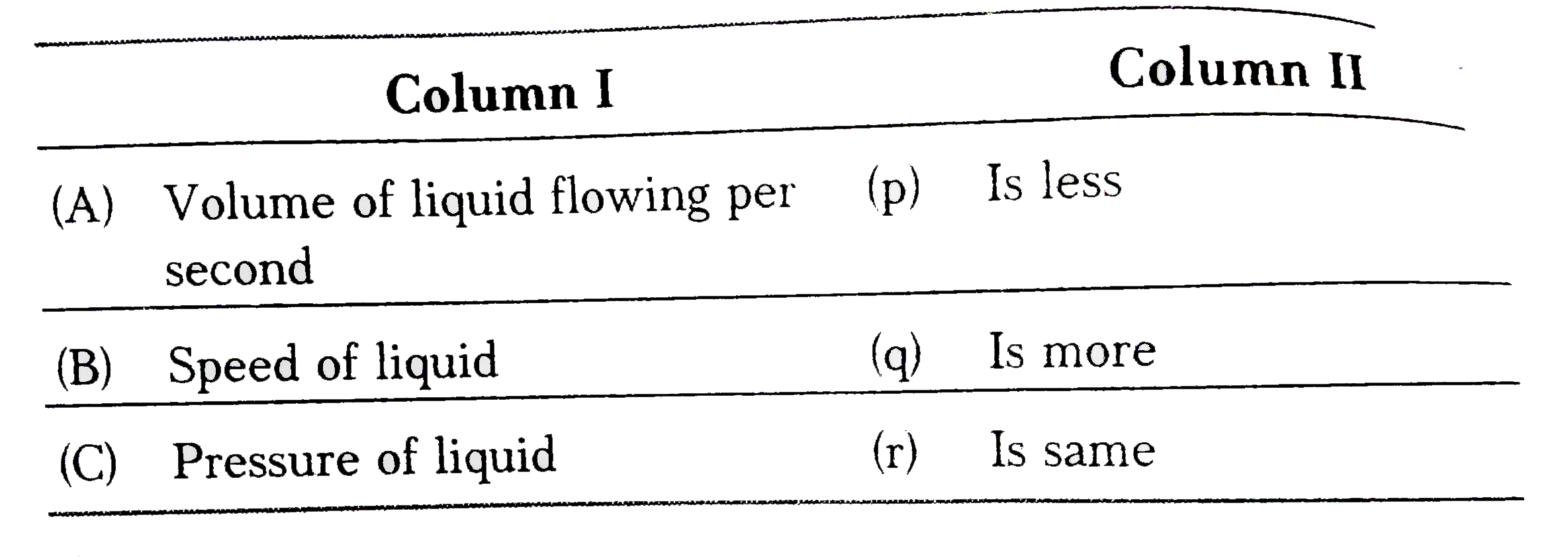An engine pumps liquid of density ρ continuously through a pipe of cross-section area A. If the speed with which liquid passes through the pipe is v, then the rate at which kinetic energy is being imparted to the liquid by the pump is
12Aρv3
12Aρv2
12Aρv
Aρv
The correct Answer is:A
To find the rate at which kinetic energy is being imparted to the liquid by the pump, we can follow these steps:
Step 1: Understand the Kinetic Energy Formula
The kinetic energy (KE) of an object with mass m moving at a speed v is given by the formula:
KE=12mv2
Step 2: Determine the Mass Flow Rate
The mass flow rate (˙m) of the liquid can be expressed in terms of its density (ρ), cross-sectional area (A), and velocity (v):
˙m=ρ⋅Q
where Q is the volumetric flow rate. The volumetric flow rate can be expressed as:
Q=A⋅v
Thus, the mass flow rate becomes:
˙m=ρ⋅(A⋅v)=ρAv
Step 3: Calculate the Rate of Kinetic Energy
The rate at which kinetic energy is imparted to the liquid (power, P) is the kinetic energy per unit time:
P=12˙mv2
Substituting the expression for ˙m:
P=12(ρAv)v2
Step 4: Simplify the Expression
Now, simplify the expression:
P=12ρAv3
Final Answer
Thus, the rate at which kinetic energy is being imparted to the liquid by the pump is:
12ρAv3
---
The kinetic energy (KE) of an object with mass m moving at a speed v is given by the formula:
KE=12mv2
The mass flow rate (˙m) of the liquid can be expressed in terms of its density (ρ), cross-sectional area (A), and velocity (v):
˙m=ρ⋅Q
where Q is the volumetric flow rate. The volumetric flow rate can be expressed as:
Q=A⋅v
Thus, the mass flow rate becomes:
˙m=ρ⋅(A⋅v)=ρAv
The rate at which kinetic energy is imparted to the liquid (power, P) is the kinetic energy per unit time:
P=12˙mv2
Substituting the expression for ˙m:
P=12(ρAv)v2
Now, simplify the expression:
P=12ρAv3
Thus, the rate at which kinetic energy is being imparted to the liquid by the pump is:
12ρAv3
Similar Questions
An engine pumps a liquid of density 'd' continuously through a pipe of area of cross-section A. If the speed with which the liquid passes through a pipe is v, then force exerted on liquid.
View SolutionA pump is used to pump a liquid of density ρ continuously through a pipe of cross, sectional area A. If liquid is flowing with speed v, then average power of pump is
View SolutionA pump is used to pump a liquid of density ρ continuously through a pipe of cross, sectional area A. If liquid is flowing with speed v, then average power of pump is
View SolutionAn engine pumps water continously through a hose. Water leave the hose with a velocity v and m is the mass per unit length of the Water jet. What is the rate at Which kinetic energy is imparted to water?
View SolutionAn engine pumps water continously through a hose. Water leave the hose with a velocity v and m is the mass per unit length of the Water jet. What is the rate at Which kinetic energy is imparted to water?
View SolutionAn engine pumps water continously through a hole. The speed with which water pases through the hole nozzle is v and k is the mass per unit length of the water jet as it leaves the nozzle. Find the rate at which kinetic energy is being imparted to the water.
View SolutionA liquid of density ρ is flowing with a speed v through a pipe of cross sectional area A. The pipe is bent in the shape of a right angles as shown. What force should be exerted on the pipe at the corner to keep it fixed?

View SolutionA liquid of density ρ is flowing with a speed V through a pipe of cross sectional area A. What force does the liquid stream exert on wall in x direction if it splashes in the form of a circle after it hits the wall?

View SolutionA liquid is flowing through a pipe of non-uniform cross-section. At a point where area of cross-section of the pipe is less, match the following columns.

View SolutionA viscous liquid flows through a horizontal pipe of varying cross-sectional area. Identify the option which correctly represents the variation of height of rise of liquid in each vertical tube
View Solution
